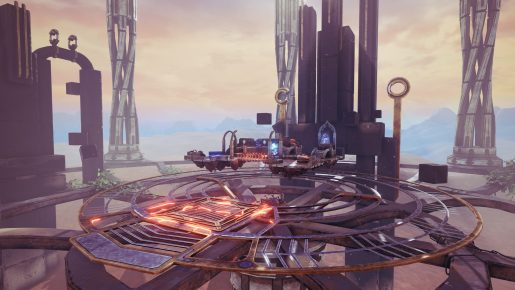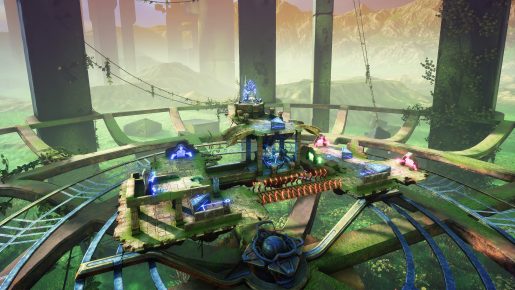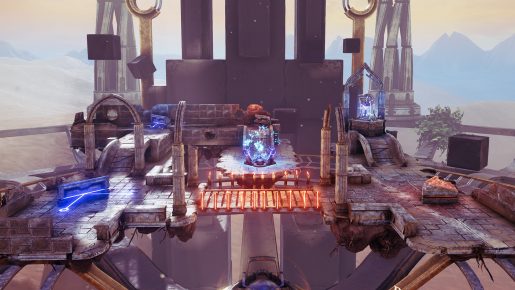Marble Land is a VR puzzle game principally for the HTC Vive and Oculus Rift from developer Devious Technologies. The puzzles all give you the simple goal of navigating a single marble through a track and onto an exit point, manipulating a number of gadgets to create a continuous path. The game supports either motion controls or a traditional controller, and even allows the game to be played in 2D using a controller or mouse and keyboard.

As with many VR-focused games the interface for Marble Land is fairly minimal, with a simple menu and no HUD elements once in-game. Simplicity also reigns in terms of available interactions, which consist only of camera movement, marble release and toggling between states for gadgets on the marble track. For each gadget there are only two states to flick between, which is achieved by pointing your controller at it and squeezing the trigger. One of the most basic gadgets is a block with a face at 45 degrees to the marble track which can be rotated to choose which way you want the marble to be directed when it bounces off; this is a staple which will be used in pretty much every puzzle. Others include bridge sections which are rotated or tipped, and boosters which can be re-oriented.
For me most of the puzzles seemed fairly easy to solve but did remain satisfying, though the perceived difficulty will vary a lot from person to person. Without getting into specifics for fear of spoiling anything, I did find that many of the puzzles adopted something of a red-herring design approach with lots of elements that aren’t needed to solve the puzzle, which makes many of the levels appear much more intimidating than they perhaps should be. Another common element of the puzzles is requiring you to use marbles to adjust parts of the level without expecting that marble to reach the goal, sacrificing it to allow a later marble to complete the course.

Moving around each puzzle level is achieved using very, very slow smooth locomotion controlled with the analogue sticks. I don’t find smooth locomotion uncomfortable most of the time anyway, but apparently the implementation is slow enough hardly anyone finds it uncomfortable in Marble Land. Unfortunately, the panning speed is slow to the point of being obnoxious, and I rarely re-oriented the puzzle at all because it is so tedious. The most obvious alternative would be to allow players to grab the level with the motion controllers and rotate, rescale or move it with hand movements; this is pretty much the standard control method in most VR games and it does seem odd that this approach wasn’t taken.
Graphically the game holds up very well, with three nice themes splitting the 45 available levels into chapters. The physics of the marbles themselves occasionally look a little strange though never to a distracting extent, and are always predictable for the purposes of solving the puzzle which is the critical thing. One little aspect of the presentation which was I did find a little odd was the choice of font used on the menus; I did not find it particularly clear but quickly worked it out.

Technically the game performs well, running at a constant 90fps, with no stuttering. On top of this the load times are fairly short even when experimenting with the game being installed on a slow storage drive. Disappointingly there are no video options available; there is literally no part of the options menu with any graphics settings to tweak. For a PC game this is an almost unforgivable oversight, for users both at the high and low ends of the hardware spectrum. For my system I am confident that the graphics could have been pushed further, so I would have liked to, at least, have seen the option to adjust the pixel density. For those unfamiliar, this is a term commonly used in VR games to describe super-sampling anti-aliasing: rendering an image at a higher resolution than the display and then down-sampling. Similarly for those with weaker hardware it would have been useful to have options to take away some graphical bells and whistles in favour of performance, so the lack of video options is something you should bear in mind if you’re in that boat.
Marble Land offers some satisfying puzzles set, in a relaxing environment. While it doesn’t do anything particularly novel it is well executed. Marble Land is not a particularly long game and will take a few hours to complete at most, with no real replay value which is of course to be expected with a puzzle game, which should be borne in mind if you are considering a purchase. Marble Land is available now on Steam and the Oculus store for $14.99 or regional equivalent.
[Editor’s Note: Marble Land was provided to us by the developer for the review. The Oculus Rift was the VR headset used to review the game.]
